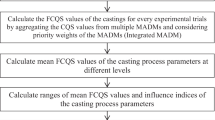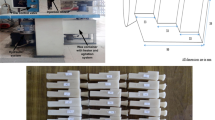Abstract
In this paper, the use of the Utility-Fuzzy-Taguchi based hybrid approach in investment casting process for optimizing multiple quality characteristics of wax patterns has been conceptualized. Selection of an appropriate orthogonal array, preference scale construction followed by preference values, generation of multi-performance index (MPI) by fuzzy logic, analysis of means and analysis of variance are employed to study the performance characteristics of the process. The control factors considered are injection temperature, injection pressure and injection time, whereas linear shrinkage, surface roughness and penetration are the corresponding responses. The optimal setting obtained by the proposed method is validated by confirmatory experiments. This concludes the application feasibility of the proposed method for parametric optimizations in investment casting process. Further, the result of the aforementioned optimization technique has been compared with that of Utility-Taguchi technique. It is found that the optimal condition for both is same, while the most influential process parameter is different in both cases due to employment of random selection of weights in Utility-Taguchi method.










Similar content being viewed by others
References
Beeley, P.R., Smart, R.F.: Investment casting, 1st edn. Institute of Materials, London (1995)
Jain, P.L.: Principles of foundry technology, 4th edn. Tata McGraw-Hill, New Delhi (2003)
Wood, R.L., Ludwig, D.V.: Investment castings for engineers. Reinhold Publishing Corporation, New York (1952)
Bonilla, W., Masood, S.H., Iovenitti, P.: An investigation of wax patterns for accuracy improvement in investment cast parts. Int. J. Adv. Manuf. Technol. 18, 348–356 (2001)
Rezavand, S.A.M., Behravesh, A.H.: An experimental investigation on dimensional stability of injected wax patterns of gas turbine blades. J. Mater. Process. Tech. 182, 580–587 (2007)
Rahmati, S., Akbari, F., Barati, E.: Dimensional accuracy analysis of wax patterns created by RTV silicone rubber molding using the Taguchi approach. Rapid Prototy** J. 13(2), 115–122 (2007)
Pattnaik, S.R., Karunakar, D.B., Jha, P.K.: Optimal selection of process parameters in investment casting process using Taguchi approach. In: Conference proceedings of WASET 61 (2012)
Singh, H., Kumar, P.: Optimizing multi-machining characteristics through Taguchi’s approach and Utility concept. J. Manuf. Technol. Manage. 17(2), 255–274 (2006)
Dubey, A.K.: Multi-response optimization of electro-chemical honing using utility-based Taguchi approach. Int. J. Adv. Manuf. Technol. 41, 749–759 (2009)
Badkar, D.S., Pandey, K.S., Buvanashekaran, G.: Parameter optimization of laser transformation hardening by using Taguchi method and Utility concept. Int. J. Adv. Manuf. Technol. 52, 1067–1077 (2011)
Pattnaik, S.R., Karunakar, D.B., Jha, P.K.: Influence of injection process parameters on dimensional stability of wax patterns made by the lost wax process using Taguchi approach. Proc. Inst. Mech. Eng. Part L: J. Mater. Design. Appl. 227(1) (2013)
Phadke, M.S.: Quality engineering using robust design, 1st edn. Englewood Cliffs, Prentice-Hall (1989)
Yang, C., Hung, S.W.: Optimising the thermoforming process of polymeric foams: an approach by using the Taguchi method and the Utility concept. Int. J. Adv. Manuf. Technol. 24, 353–360 (2004)
Kaladhar, M., Subbaiah, K.V., Rao, C.S., Rao, K.N.: Application of Taguchi approach and Utility concept in solving the multi-objective problem when turning AISI 202 austenitic stainless steel. J. Eng. Sc. Technol. Rev. 4(1), 55–61 (2011)
Ravi, B.: Metal casting computer aided design and analysis, 6th edn. Prentice hall of India, New Delhi (2005)
Zadeh, L.: Fuzzy sets. Inform. Control. 8, 338–353 (1965)
Author information
Authors and Affiliations
Corresponding author
Rights and permissions
About this article
Cite this article
Pattnaik, S., Karunakar, D.B. & Jha, P.K. Utility-Fuzzy-Taguchi based hybrid approach in investment casting process. Int J Interact Des Manuf 8, 77–89 (2014). https://doi.org/10.1007/s12008-013-0183-2
Received:
Accepted:
Published:
Issue Date:
DOI: https://doi.org/10.1007/s12008-013-0183-2




